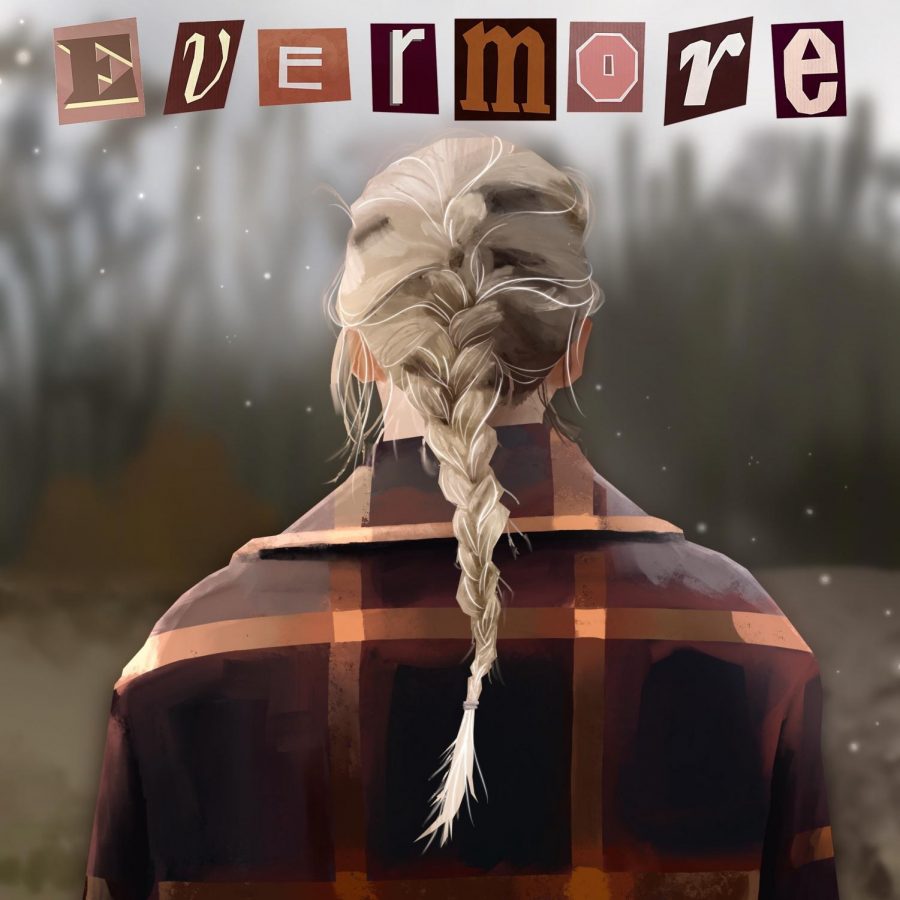Taylor Swift’s ‘evermore’–A Quarantine Masterpiece
January 28, 2021
Rating: 5/5 Falcons
The 2010s were the decade in which Taylor Swift dominated pop culture–her name was constantly circulating in tabloids and gossip pages, she became the first female artist to win the coveted Album of the Year Grammy twice, and was even named Artist of the Decade by the American Music Awards. Swift’s decade-long monumental run was expected to continue in 2020. She was primed to go on a world tour to support her seventh studio album, Lover, and was set to become the first female artist to open an NFL stadium, scheduled to perform at the new SoFi stadium in Los Angeles. Unsurprisingly, Swift had a lot of time on her hands when the pandemic canceled all of her big plans. Swift was able to release two studio albums, folklore and evermore, both potentially the best of her career.
Enlisting Aaron Dessner from The National and her longtime collaborator Jack Antonoff as co-producers for both folklore and evermore, Swift leaves behind her flashy synth-pop sound, and takes on a new indie-folk and alternative rock influence that puts her songwriting at the forefront of her music. Swift also sheds the bright, colorful, aesthetic she adopted during Lover. folklore was somber and stark in both its instrumentals and lyrics, with songs covering heavy topics like dealing with a substance addiction, or being a healthcare worker during the pandemic. This bleakness is further explored on evermore on tracks such as “tolerate it,” a wistful piano ballad about the feeling of desperation that comes with being trapped in a relationship with a person who doesn’t fully appreciate you. Written in a 5/4 time signature, “tolerate it” is one of the most musically experimental songs Swift has ever penned, and it pays off well: each line bleeds into the next, hovering for a second too long, as if mimicking the painful feeling of being stuck in the presence of somebody you once loved, but can no longer relate to.
Swift described evermore as a companion album to folklore, however, she cited the seasons associated with each album as the main differentiation between the two (folklore represents the seasons of spring and summer, and evermore covers autumn and winter). Wintry is the perfect way to describe evermore, with the cozy production and holiday themes on tracks like “‘tis the damn season,” Swift’s personal spin on the classic holiday hookup trope.
In terms of storytelling, folklore and evermore shift away from Swift’s infamously diaristic songs. Swift instead serves as a narrator to intricate characters and storylines she dreamt up. She does this on the wholesome “cowboy like me,” which follows the tale of two con-artists who end up falling in love with each other, or on the beautiful “champagne problems,” which recounts the fallout of a relationship after a rejected proposal. She tells another story on “ivy,” which follows a married woman falling in love with somebody outside her marriage–Swift uses a brilliant metaphor of an ivy plant symbolizing the woman’s growing infatuation with this person, singing, “My house of stone / your ivy grows / and now I’m covered in you.”
Swift has always been self-aware in her work, yet with evermore she comes back notably wiser. With lyrics like “falling feels like flying ‘til the bone crush” on “gold rush,” or “if the shoe fits, walk in it everywhere you go” on “long story short,” Swift provides advice to her listeners, as not to make the same mistakes she did. However, it is on “marjorie,” a tribute to her late grandmother Marjorie Finlay, where she sounds the most insightful. The song opens on a soft drone–synths clatter together like fragments of half-forgotten childhood memories—before the first piano chord seeps in and Swift softly advises “never be so kind you forget to be clever / never be so clever you forget to be kind.” The instrumental on “Marjorie” builds subtly as the song continues, but feels so satisfying by the time you notice its blooming buildup by the chilling bridge–the result is one of Swift’s most mature and beautiful works.
Although the momentum in Swift’s albums tends to lag in the final stretch, evermore succeeds in keeping its consistency. “closure” is another beautifully written song in a 5/4 time signature, and the title track “evermore” is the perfect closing number co-written with collaborator Justin Vernon from Bon Iver. Vernon’s voice perfectly compliments Swift’s on an anxious bridge akin to that on “exile,” their previous collaboration on folklore.
On evermore, Swift once again proves her prowess as an albums-artist, unlike her pop peers. Her attentiveness for the craft of an album is admirable, making it no surprise that she recently became the female artist with the most weeks at number one on the Billboard albums chart, with 45 cumulative weeks at number one as of January. Swift is an artist who constantly has new surprises up her sleeve, and as always, it will be exciting to see which direction she chooses to take next in her career.










